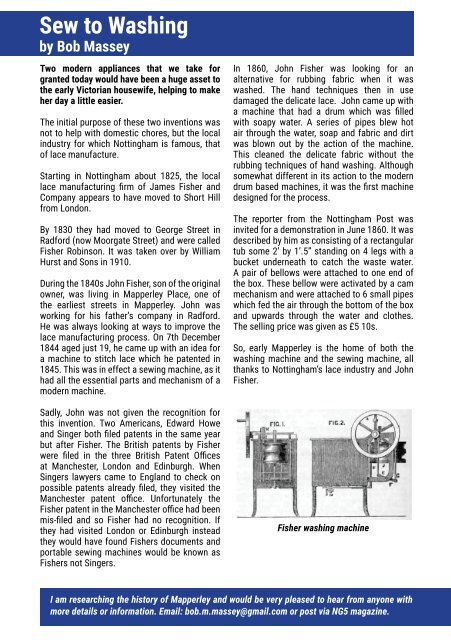NG3 Sept/Oct 2020
Local business directory and community magazine
Local business directory and community magazine
You also want an ePaper? Increase the reach of your titles
YUMPU automatically turns print PDFs into web optimized ePapers that Google loves.
Sew to Washing<br />
by Bob Massey<br />
Two modern appliances that we take for<br />
granted today would have been a huge asset to<br />
the early Victorian housewife, helping to make<br />
her day a little easier.<br />
The initial purpose of these two inventions was<br />
not to help with domestic chores, but the local<br />
industry for which Nottingham is famous, that<br />
of lace manufacture.<br />
Starting in Nottingham about 1825, the local<br />
lace manufacturing firm of James Fisher and<br />
Company appears to have moved to Short Hill<br />
from London.<br />
By 1830 they had moved to George Street in<br />
Radford (now Moorgate Street) and were called<br />
Fisher Robinson. It was taken over by William<br />
Hurst and Sons in 1910.<br />
During the 1840s John Fisher, son of the original<br />
owner, was living in Mapperley Place, one of<br />
the earliest streets in Mapperley. John was<br />
working for his father’s company in Radford.<br />
He was always looking at ways to improve the<br />
lace manufacturing process. On 7th December<br />
1844 aged just 19, he came up with an idea for<br />
a machine to stitch lace which he patented in<br />
1845. This was in effect a sewing machine, as it<br />
had all the essential parts and mechanism of a<br />
modern machine.<br />
Sadly, John was not given the recognition for<br />
this invention. Two Americans, Edward Howe<br />
and Singer both filed patents in the same year<br />
but after Fisher. The British patents by Fisher<br />
were filed in the three British Patent Offices<br />
at Manchester, London and Edinburgh. When<br />
Singers lawyers came to England to check on<br />
possible patents already filed, they visited the<br />
Manchester patent office. Unfortunately the<br />
Fisher patent in the Manchester office had been<br />
mis-filed and so Fisher had no recognition. If<br />
they had visited London or Edinburgh instead<br />
they would have found Fishers documents and<br />
portable sewing machines would be known as<br />
Fishers not Singers.<br />
In 1860, John Fisher was looking for an<br />
alternative for rubbing fabric when it was<br />
washed. The hand techniques then in use<br />
damaged the delicate lace. John came up with<br />
a machine that had a drum which was filled<br />
with soapy water. A series of pipes blew hot<br />
air through the water, soap and fabric and dirt<br />
was blown out by the action of the machine.<br />
This cleaned the delicate fabric without the<br />
rubbing techniques of hand washing. Although<br />
somewhat different in its action to the modern<br />
drum based machines, it was the first machine<br />
designed for the process.<br />
The reporter from the Nottingham Post was<br />
invited for a demonstration in June 1860. It was<br />
described by him as consisting of a rectangular<br />
tub some 2’ by 1’.5” standing on 4 legs with a<br />
bucket underneath to catch the waste water.<br />
A pair of bellows were attached to one end of<br />
the box. These bellow were activated by a cam<br />
mechanism and were attached to 6 small pipes<br />
which fed the air through the bottom of the box<br />
and upwards through the water and clothes.<br />
The selling price was given as £5 10s.<br />
So, early Mapperley is the home of both the<br />
washing machine and the sewing machine, all<br />
thanks to Nottingham’s lace industry and John<br />
Fisher.<br />
Fisher washing machine<br />
I am researching the history of Mapperley and would be very pleased to hear from anyone with<br />
more details or information. Email: bob.m.massey@gmail.com or post via NG5 magazine.


















